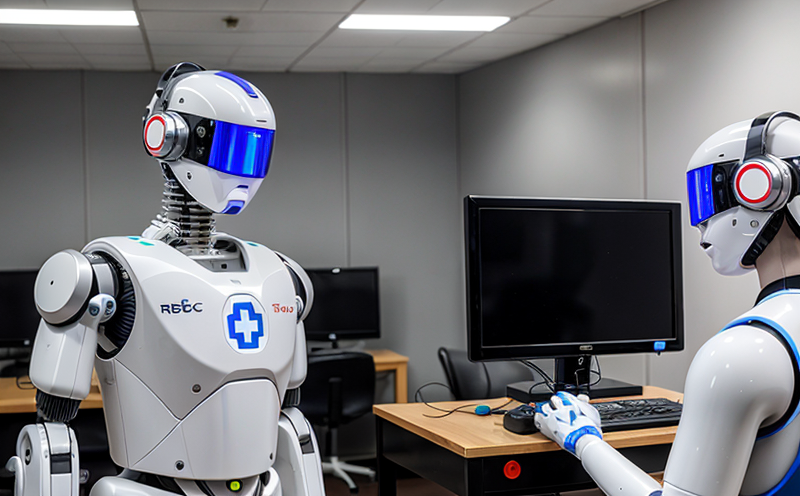ISO 10993-10 Irritation and Sensitization Testing in Medical Robots
The ISO 10993 series of standards is a cornerstone for ensuring the safety and efficacy of medical devices, including those that incorporate advanced robotics. The ISO 10993-10: Biological Evaluation of Medical Devices—Part 10: Irritation and Sensitization Testing specifically addresses the biological evaluation to identify potential irritant or sensitizing properties of materials used in medical robots.
This testing is critical because even advanced robotic systems that are otherwise safe can pose risks if they introduce irritants or allergens into the body. The purpose of this standard is to evaluate whether a material will cause irritation, inflammation, or allergic reactions when it comes into direct contact with human tissues during use.
The test parameters for ISO 10993-10 are stringent and designed to mimic real-world conditions as closely as possible. The testing involves submerging the specimen of interest (typically a component or material used in the robot) into a simulated tissue environment, such as physiological saline, for periods ranging from 24 hours up to one month depending on the type of test. Specimens are then evaluated for any signs of irritation or sensitization.
The acceptance criteria for this testing are based on visual inspection and histopathological analysis. The standard specifies that no visible or microscopic evidence of inflammation, necrosis, or other adverse effects should be present to pass the test.
Testing under ISO 10993-10 is essential for ensuring compliance with international regulations such as those outlined in the US FDA's 510(k) process and CE marking requirements. This testing helps manufacturers demonstrate that their medical robots meet the necessary safety standards before entering the market.
The following table provides a breakdown of common test parameters used in ISO 10993-10 irritation and sensitization testing:
| Test Parameter | Description | Purpose |
|---|---|---|
| Duration of Exposure | The length of time the specimen is exposed to the simulated tissue environment. | To ensure that any potential irritant or sensitizing effects are observed over a sufficient period. |
| Type of Simulated Tissue Environment | Physiological saline, serum, or other relevant biological fluids. | To mimic the conditions under which the medical robot will be used in the human body. |
The use of this testing is not limited to traditional materials but also extends to advanced robotic components such as prosthetics, surgical robots, and wearable devices. By incorporating ISO 10993-10 into their development process, manufacturers can ensure that all aspects of the medical robot are safe for human interaction.
Here is a list of common specimen preparation methods used in ISO 10993-10 testing:
- Cutting the specimen to standard sizes and shapes.
- Cleaning the specimen with appropriate solvents or detergents.
- Ensuring that the specimen is free from any contamination prior to testing.
- Submerging the specimen in the simulated tissue environment for the required duration.
Environmental and Sustainability Contributions
The ISO 10993-10 irritation and sensitization testing contributes to environmental sustainability by ensuring that medical robots are safe not only for patients but also for the environment. By reducing the risk of adverse reactions, these tests help minimize waste from discarded devices and reduce healthcare costs associated with patient care.
- Reduces the need for post-market recalls due to safety issues.
- Promotes the use of safer materials in robotic components, which can be recycled more easily.
- Encourages manufacturers to innovate and design products that meet stringent safety standards without compromising performance.
Competitive Advantage and Market Impact
Compliance with ISO 10993-10 irritation and sensitization testing is a key differentiator in the medical robotics market. By ensuring that their products are safe, manufacturers can build trust with healthcare providers and patients alike.
- Enhances brand reputation and customer confidence.
- Paves the way for easier regulatory approval processes in multiple jurisdictions.
- Facilitates faster market entry by meeting international standards upfront.
Use Cases and Application Examples
The ISO 10993-10 irritation and sensitization testing is particularly relevant for medical robots that come into direct contact with the human body. Here are some specific use cases:
| Use Case | Description | Testing Requirements |
|---|---|---|
| Surgical Robots | Robots used for minimally invasive surgeries, such as the da Vinci Surgical System. | Test all components that come into contact with tissues during surgery. |
| Prosthetics and Orthotics | Devices like robotic arms or exoskeletons designed to replace lost limbs. | Ensure the materials used in these devices do not cause irritation when worn for extended periods. |





